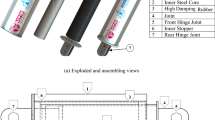Abstract
Thin-wall water piping systems are key to the functionality of important facilities, such as hospitals and schools. Recent earthquakes have demonstrated the vulnerability of these systems. Conventional bracing of thin-wall water piping systems does not guarantee adequate seismic performance. Due to their flexibility, dynamic amplification of long piping runs between bracing elements can occur. This paper evaluates, through a case study, the feasibility of introducing viscous dampers within bracing elements of suspended thin-wall water piping systems to improve seismic performance. Three-dimensional dynamic response analyses were conducted on a suspended thin-wall water piping system under seismic floor motions of various intensities. The dynamic response of the piping system with viscously damped bracing is compared to that of the unbraced and conventionally braced piping system. The numerical results indicate an improvement in seismic response for viscously damped braced configurations. The properties of the viscous dampers that causes the largest reductions in the seismic response of the piping system are noted and practical implementation aspects are discussed.


(after Welch and Sullivan 2017)



















Similar content being viewed by others
References
Antaki G, Guzy D (1998) Seismic testing of grooved and threaded fire protection joints and correlation with NFPA seismic design provisions. In: ASME proceedings, pressure vessels and piping division, PVP-vol 364, seismic engineering, pp 69–75
Ayres JM, Ezer Associates Inc (1996) Northridge earthquake hospital water damage study. Office of Statewide Health Planning and Development, Sacramento
Carr AJ (2010) RUAUMOKO volume 3: user manual for the 3-dimensional version Ruaumoko3D, Computer Program Library, Dept. of Civil Engineering, University of Canterbury, Christchurch, NZ, 164 p
Chock G (2006) Preliminary observations on the Hawaii earthquakes of October 15, 2006. EERI Special Earthquake Report
Christopoulos C, Filiatrault A (2006) Principles of supplemental damping and seismic isolation. IUSS Press, Istituto Universitario di Studi Superiori di Pavia, Pavia, p 500
Dillingham JS, Goel RK (2002) Dynamic properties of fire sprinkler systems. Report CP/SEAM-2002/04
FEMA (2009) Quantification of building seismic performance factors, FEMA P695, Federal Emergency Management Agency (FEMA P695), Washington, D.C., 421 p
Goodwin ER, Maragakis EM, Itani AM (2007) Experimental evaluation of the seismic performance of hospital piping subassemblies. Technical Report MCEER-07-0013, Multidisciplinary Center for Earthquake Engineering Research
Hilti (2014) Earthquake resistant design of installations. Ed 1.1, Schaan, Liechtenstein, 104 p
Hoehler MS, Panagiotou M, Restrepo JI, Silva JF, Floriani L, Bourgund U, Gassner H (2009) Performance of suspended pipes and their anchorages during shake table testing of a seven-story building. Earthq Spectra 25(1):71–91
Ju BS (2011) Seismic fragility of piping system. Ph.D. Dissertation, Department of Civil Engineering, North Carolina State University, Raleigh, North Carolina
Kumar P, Jangidb RS, Reddya GR (2016) Comparative performance of passive devices for piping system under seismic excitation. Nucl Eng Des 298:121–134
Martinez GES (2007) A comparative study of a piping system subjected to earthquake loads using finite element modelling and analysis. In: Proceedings of the 2007 earthquake engineering symposium for young researchers, Seattle, WA, pp 31–51
Meacham B, Kim JK, Park H (2013) Full-scale structural and nonstructural building system performance during earthquakes and post earthquake fire: fire test program and outcomes. Technical Report BNCS, Department of Fire Protection Engineering, Worcester Polytechnic Institute, Worcester, MA
OSHPD (1995) The Northridge earthquake: a report to the hospital building safety board on the performance of hospitals. Office of Statewide Health Planning and Development, Facilities Development Division, Sacramento
Priestley MJN, Calvi GM, Kowalsky MJ (2007) Displacement-based seismic design of structures. IUSS Press, Istituto Universitario di Studi Superiori di Pavia, Pavia, p 721
Tian Y, Filiatrault A, Mosqueda G (2014) Experimental seismic fragility of pressurized fire suppression sprinkler piping joints. Earthq Spectra 30(4):1733–1748
Tian Y, Filiatrault A, Mosqueda G (2015a) Seismic response of pressurized fire sprinkler piping systems I: experimental study. J Earthq Eng 19(4):649–673
Tian Y, Filiatrault A, Mosqueda G (2015b) Seismic response of pressurized fire sprinkler piping systems II: numerical study. J Earthq Eng 19(4):674–699
Welch DP, Sullivan TJ (2017) Illustrating a new possibility for the estimation of floor spectra in nonlinear multi-degree of freedom systems. In: Proceedings of the 16th world conference on earthquake engineering (16WCEE), Santiago, Chile, January 9–13, 2017, Paper No. 2632
Acknowledgements
The Erasmus Mundus Programme is gratefully acknowledged for having provided financial support to the first author of this paper. The authors are also thankful to Clemens Beiter and Stefano Eccheli from Hilti for their assistance in the selection of the piping configuration used in the parametric study and to Dr. David Welch for generating the input floor motions used for the analyses.
Author information
Authors and Affiliations
Corresponding author
Additional information
Marc Tatarsky: Formally Graduate Student at School for Advanced Studies IUSS Pavia, Palazzo del Broletto, Piazza della Vittoria n.15, 27100 Pavia, Italy.
Rights and permissions
About this article
Cite this article
Tatarsky, M., Filiatrault, A. Seismic response of viscously damped braced thin-wall piping system: a proof-of-concept case study. Bull Earthquake Eng 17, 537–559 (2019). https://doi.org/10.1007/s10518-018-0447-0
Received:
Accepted:
Published:
Issue Date:
DOI: https://doi.org/10.1007/s10518-018-0447-0




